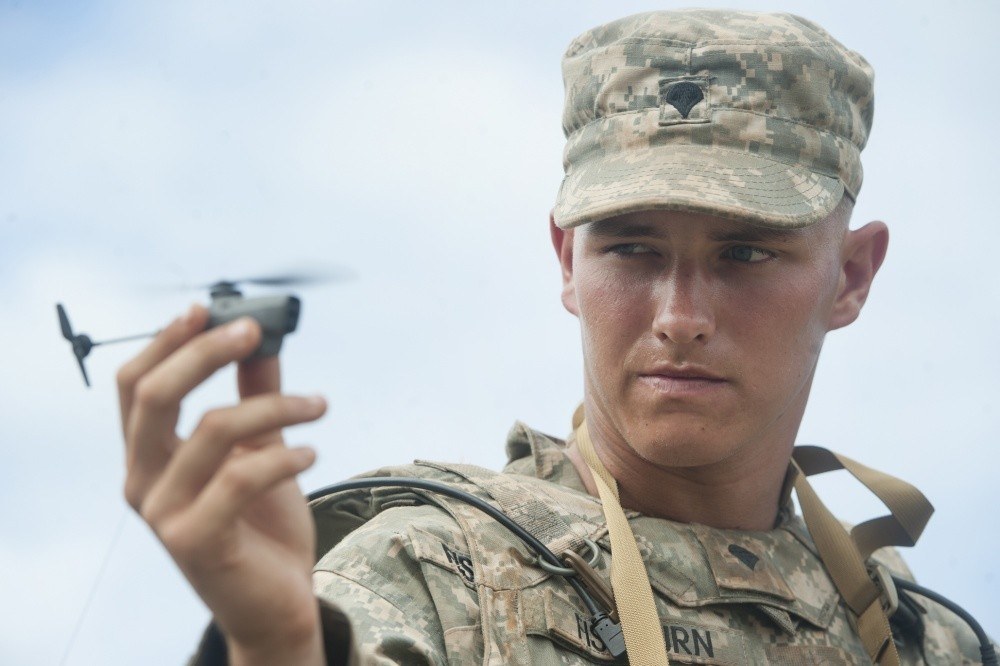
Black Hornet, we choose you, says Hawaii-based US soldiers who participated in the recent Pacific Manned-Unmanned Initiative (PACMAN-I). PACMAN-I is a program in which the US Military tests out new technologies, particularly the effectiveness of robots or drones in the battlefield, how they can actually benefit soldiers in a war zone. The world got a glimpse of that first-hand when a bomb disposal robot was used to subdue a sniper during the recent Dallas shooting incident.
“…We need to be making sure we’re fielding new technology as quickly as we can… It doesn’t do any good if we’re just investing in great technology if we don’t actually get it into the field for soldiers.”
— Eric Fanning, Secretary of the Army
The technology is practically here as many tech companies feature various advanced robots that mimic human strides, robots that move similarly to four-legged mammals, some of which are reminiscent of the cassette Transformer Ravage. The Laserbeak drone is not far behind as photos of a bird-like drone with flapping wings shot down by soldiers circulate around the web. Robots such as these immediately sparks visions of military use especially the creepy prototypes created by Boston Dynamics. While powerful modern tanks and planes were featured in recent wars, subsequent wars could soon feature the use of 21st-century robotics and drone technology as well as massive cyber-attacks. In fact, there may already be a cold war happening in cyberspace as evidenced by attacks on government offices and military installations. Debates are already up whether or not artificially intelligent robotic drones should be used to kill or maim soldiers on the battlefield.
The remote robotics arms race has begun, and the US is not alone in this kind of research. China has been busy too either from homebrew research or derived from external sources. Last January, the US has accused China of stealing military robot designs. Whether this is true or not, the US needs to always be one step ahead. It should be like the Department of Defense annually spends billions of R&D. Programs like the PACMAN-I are used to make sure the results of these research become battle-worthy.
“Machines don’t get tired. They don’t close their eyes. They don’t hide under trees when it rains, and they don’t talk to their friends … A human’s attention to detail on guard duty drops dramatically in the first 30 minutes … Machines know no fear.”
— Major Kenneth Rose, US Army Training and Doctrine Command
The 25th Infantry Division was tasked to test out various robots from tech companies, but the soldiers are enthusiastic of one particular drone called the PD-100 Black Hornet from manufactured by Prox Dynamics. The Black Hornet is a tiny drone that can fit on a person’s palm. It can fly for 25 minutes on a single charge and has steerable cameras which makes it perfect for reconnaissance missions for up to a mile and a half away. It’s one step away from being a fly on the wall or close enough to the robotic insect featured in Transformers: Revenge of the Fallen. Soldiers can recon continuously with two units. One unit can recon the area while the other is charging on the soldier’s backpack charger. Speed and stealth are important for reconnaissance missions and the PD-100 easily fits the bill as the drone can fly silently compared to ordinary copters of the same size. Also, because of the Black Hornet’s size, it can easily be mistaken for a bird by untrained eyes.
“…That was a system that we could actually take right now…on the battlefield… Some of these other systems, as with any electronics and robotics, there are some things that have to be worked out,”
— Staff Sergeant James Roe, statement for Breaking Defense
With regards to speed and stealth, some of the systems tested on these programs failed to be all that they can be. One of these is the Legged Squad Support System developed by Boston Dynamics. The DoD spent over 32 million dollars for this system that will serve as a robotic pack mule to carry weapons and supplies but failed to make the cut because of excessive noise. Whoever said all well-funded endeavors are always successful? There are plenty of examples on KickStarter.
Another failed experiment is the Multipurpose Unmanned Tactical Transport (MUTT), developed by a company called General Dynamics. MUTT is a tank-like robot that looks like something cooked up by Man-at-Arms of Eternia. It’s designed to carry loads like Boston Dynamics’ LSSS. It managed to keep the noise down, but the military took issue with its speed. The robot couldn’t keep up with soldiers on rough terrain. It’s not a robot for the trenches but could work out in urban warfare.
The PACMAN-I program has proven that ground-based robots could use another round of adjustments, but the PD-100 Black Hornet Poke-drone could soon be looking over your shoulder.

